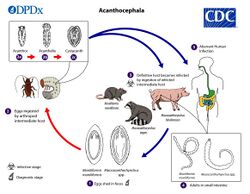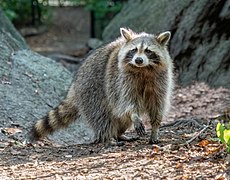Biology:Macracanthorhynchus
| Macracanthorhynchus | |
|---|---|

| |
| Adult Macracanthorhynchus hirudinaceus | |
| Scientific classification | |
| Domain: | Eukaryota |
| Kingdom: | Animalia |
| Phylum: | Acanthocephala |
| Class: | Archiacanthocephala |
| Order: | Oligacanthorhynchida |
| Family: | Oligacanthorhynchidae |
| Genus: | Macracanthorhynchus Trevassos, 1917 |
| Species | |
| |
Macracanthorhynchus, also known as the giant thorny-headed worm of swine, is a member of the Oligacanthorhynchidae which contains four species.
Taxonomy
Phylogenetic analysis has been conducted on at least one of the four species in the genus, M. ingens, and confirms that this species beongs to the family Oligacanthorhynchidae.[1] The type species is M. hirudinaceus.[2]
| Archiacanthocephala | ||||||||||||||||||||||||||||||||||||
| ||||||||||||||||||||||||||||||||||||
| Phylogenetic reconstruction for select species in the class Archiacanthocephala based on a 28S rRNA gene comparison from Gomes et. al (2019) and a 18S rDNA gene comparison from Amin et al. (2020).[3][4] Amin et al. (2022) used the 18S rDNA gene and ITS1-5.8-ITS2 region of ribosomal RNA comparisons to add P. canicola phylogenetically to the family Oligacanthorhynchidae.[1] |
Description
Species
There are four species in the genus Macracanthorhynchus.[2][5][lower-alpha 1]
- Macracanthorhynchus catulinus Kostylev, 1927
- Macracanthorhynchus erinacei Dollfus, 1953
- Macracanthorhynchus hirudinaceus (Pallas, 1781)
M. hirudinaceus is a parasite which lives in the intestines of pigs and other suids, and very occasionally in humans or dogs. It causes enteritis, gastritis or peritonitis. Its life cycle includes beetles of the genus Melolontha as intermediate hosts.[citation needed] This species has many synonyms which include: Echinorhynchus gigas (Block, 1782), Macracanthorhynchus gigas (Block, 1782),[6] Echinorhynchus hirundinacea (Palas, 1781), Gigantorhynchus hirundinaceus (Pallas, 1781), Gigantorhynchus gigas (Block, 1782),[7] Hormorhynchus gigas (Block, 1782), Taenia haeruca (Pallas, 1776), and Taenia hirundinaceus (Pallas, 1781)[8] The complete mitochondrial genome of M. hirudinaceus has been sequenced.[9] The eggs have 4 membranes are 98 um long and have an elongation ratio of 1.85.[10]
- Macracanthorhynchus ingens (Linstow, 1879)
The eggs have 3 membranes are 94 um long and have an elongation ratio of 1.66.[10] It parasitizes the raccoon (Procyon lotor) in the United States .[4]
Hosts

The life cycle of an acanthocephalan consists of three stages beginning when an infective acanthor (development of an egg) is released from the intestines of the definitive host and then ingested by an arthropod, the intermediate host. The intermediate hosts of Macracanthorhynchus include beetles. When the acanthor molts, the second stage called the acanthella begins. This stage involves penetrating the wall of the mesenteron or the intestine of the intermediate host and growing. The final stage is the infective cystacanth which is the larval or juvenile state of an Acanthocephalan, differing from the adult only in size and stage of sexual development. The cystacanths within the intermediate hosts are consumed by the definitive host, usually attaching to the walls of the intestines, and as adults they reproduce sexually in the intestines. The acanthor are passed in the feces of the definitive host and the cycle repeats. There are no known paratenic hosts (hosts where parasites infest but do not undergo larval development or sexual reproduction) for Macracanthorhynchus.[12]
- Hosts for Macracanthorhynchus
Notes
- ↑ A binomial authority in parentheses indicates that the species was originally described in a genus other than the present genus.
References
- ↑ Jump up to: 1.0 1.1 Amin, Omar M.; Chaudhary, Anshu; Heckmann, Richard A.; Swenson, Julie; Singh, Hridaya S. (2022-03-01). "Redescription and Molecular Characterization of Pachysentis canicola Meyer, 1931 (Acanthocephala: Oligacanthorhynchidae) from the Maned Wolf, Chrysocyon brachyurus (Illiger, 1815) in Texas" (in en). Acta Parasitologica 67 (1): 275–287. doi:10.1007/s11686-021-00458-5. PMID 34345996. https://doi.org/10.1007/s11686-021-00458-5. Retrieved 28 December 2022.
- ↑ Jump up to: 2.0 2.1 Amin, Omar M. (September 19, 2013). "Classification of the Acanthocephala". Folia Parasitologica 60 (4): 273–305. doi:10.14411/fp.2013.031. PMID 24261131.
- ↑ Gomes, Ana Paula N.; Amin, Omar M.; Olifiers, Natalie; Bianchi, Rita de Cassia; Souza, Joyce G. R.; Barbosa, Helene S.; Maldonado, Arnaldo (2019). "A New Species of Pachysentis Meyer, 1931 (Acanthocephala: Oligacanthorhynchidae) in the Brown-Nosed Coati Nasua nasua (Carnivora: Procyonidae) from Brazil, with Notes on the Genus and a Key to Species". Acta Parasitologica 64 (3): 587–595. doi:10.2478/s11686-019-00080-6. PMID 31286360.
- ↑ Jump up to: 4.0 4.1 Amin, O.M.; Sharifdini, M.; Heckmann, R.A.; Zarean, M. (2020). "New perspectives on Nephridiacanthus major (Acanthocephala: Oligacanthorhynchidae) collected from hedgehogs in Iran". Journal of Helminthology 94: e133. doi:10.1017/S0022149X20000073. PMID 32114988.
- ↑ "Macracanthorhynchus Travassos, 1917". November 3, 2023. https://www.itis.gov/servlet/SingleRpt/SingleRpt?search_topic=TSN&search_value=196613#null.
- ↑ "Acanthocephala". http://insects.tamu.edu/research/collection/hallan/Acanthocephala/Family/Oligacanthorhynchidae.txt.
- ↑ Zoonosis y Enfermedades Transmisibles Comunes al Hombre y a los Animales: Parasitosis, Pan American Health Org. 3 edition (31 Dec 2003) ISBN:978-92-75-31993-2
- ↑ ITIS - Macracanthorhynchus hirudinaceus
- ↑ "Macracanthorhynchus hirudinaceus (ID 15792) - Genome - NCBI". https://www.ncbi.nlm.nih.gov/genome/15792.
- ↑ Jump up to: 10.0 10.1 Pfenning, A. C. (2017). Egg morphology, dispersal, and transmission in acanthocephalan parasites: integrating phylogenetic and ecological approaches.Url=https://via.library.depaul.edu/cgi/viewcontent.cgi?article=1273&context=csh_etd
- ↑ CDC’s Division of Parasitic Diseases and Malaria (April 11, 2019). "Acanthocephaliasis". Center for Disease Control. https://www.cdc.gov/dpdx/acanthocephaliasis/index.html.
- ↑ Schmidt, G.D. (1985). "Development and life cycles". Biology of the Acanthocephala. Cambridge: Cambridge Univ. Press. pp. 273–305. https://core.ac.uk/download/pdf/17218255.pdf. Retrieved 16 July 2023.
Wikidata ☰ {{{from}}} entry
 |


